Magnetic and Terahertz–Infrared Properties of Nanodispersed Hexaferrite SrxBa(1−x)Fe12O19 Solid Solutions
Abstract
:1. Introduction
2. Materials and Methods
3. Results and Discussion
3.1. XRD Analysis
3.2. Morphological Analysis
3.3. DSC Analysis
3.4. Magnetic Measurements
3.5. Terahertz–Infrared Spectroscopy
4. Conclusions
Supplementary Materials
Author Contributions
Funding
Data Availability Statement
Acknowledgments
Conflicts of Interest
References
- Pullar, R.C. Hexagonal Ferrites: A Review of the Synthesis, Properties and Applications of Hexaferrite Ceramics. Prog. Mater. Sci. 2012, 57, 1191–1334. [Google Scholar] [CrossRef]
- Nikmanesh, H.; Hoghoghifard, S.; Hadi-Sichani, B. Study of the Structural, Magnetic, and Microwave Absorption Properties of the Simultaneous Substitution of Several Cations in the Barium Hexaferrite Structure. J. Alloys Compd. 2019, 775, 1101–1108. [Google Scholar] [CrossRef]
- Hashhash, A.; Hassen, A.; Baleidy, W.S.; Refai, H.S. Impact of Rare-Earth Ions on the Physical Properties of Hexaferrites Ba0.5Sr0.5RE0.6Fe11.4O19, (RE = La, Yb, Sm, Gd, Er, Eu, and Dy). J. Alloys Compd. 2021, 873, 159812. [Google Scholar] [CrossRef]
- Zhuravlev, V.A.; Nevmyvaka, A.A.; Itin, V.I.; Svetlichnyi, V.A.; Lapin, I.N.; Wagner, D.V. Influence of the Reagent Types on the Characteristics of Barium Hexaferrites Prepared by Mechanochemical Method. Mater. Today Commun. 2019, 21, 100614. [Google Scholar] [CrossRef]
- Gunanto, Y.E.; Izaak, M.P.; Sitompul, H.; Adi, W.A. Composite Paint Based on Barium-Strontium-Hexaferrite as an Absorber of Microwaves at X-Band Frequency. Mater. Today Proc. 2019, 13, 1–4. [Google Scholar] [CrossRef]
- Brightlin, B.C.; Balamurugan, S. Magnetic, Micro-Structural, and Optical Properties of Hexaferrite, BaFe12O19 Materials Synthesized by Salt Flux-Assisted Method. J. Supercond. Nov. Magn. 2017, 30, 215–225. [Google Scholar] [CrossRef]
- Verma, S.; Chawla, A.; Pushkarna, I.; Singh, A.; Godara, S.K.; Pathak, D.K.; Kumar, R.; Singh, M. Understanding the Phase Evolution with Temperature in Pure (BaFe12O19) and Zinc-Zirconium Co-Doped Barium Hexaferrite (BaZnZrFe10O19) Samples Using Pawley and Rietveld Analysis. Mater. Today Commun. 2021, 27, 102291. [Google Scholar] [CrossRef]
- Joseph, N.; Kaipamangalath, A.; Varma, M.R.; Thomas, S. Size Controlled Growth of Barium Hexaferrite Platelets Using Salt Assisted Sol-Gel Technique. Mater. Chem. Phys. 2021, 272, 124971. [Google Scholar] [CrossRef]
- Godara, S.K.; Kaur, V.; Chuchra, K.; Narang, S.B.; Singh, G.; Singh, M.; Chawla, A.; Verma, S.; Bhadu, G.R.; Chaudhari, J.C.; et al. Impact of Zn2+-Zr4+ Substitution on M-Type Barium Strontium Hexaferrite’s Structural, Surface Morphology, Dielectric and Magnetic Properties. Results Phys. 2021, 22, 103892. [Google Scholar] [CrossRef]
- Patel, C.D.; Dhruv, P.N.; Meena, S.S.; Singh, C.; Kavita, S.; Ellouze, M.; Jotania, R.B. Influence of Co4+-Ca2+ Substitution on Structural, Microstructure, Magnetic, Electrical and Impedance Characteristics of M-Type Barium–Strontium Hexagonal Ferrites. Ceram. Int. 2020, 46, 24816–24830. [Google Scholar] [CrossRef]
- Almessiere, M.A.; Slimani, Y.; Güngüneş, H.; Baykal, A.; Alhamed, N.A.; Trukhanov, A.V.; Trukhanov, S.V. Structure, Mössbauer and AC Susceptibility of Strontium Nanohexaferrites: Effect of Vanadium Ions Doping. Ceram. Int. 2019, 45, 11615–11624. [Google Scholar] [CrossRef]
- Kaman, O.; Kubániová, D.; Knížek, K.; Kubíčková, L.; Klementová, M.; Kohout, J.; Jirák, Z. Structure and Magnetic State of Hydrothermally Prepared Mn-Zn Ferrite Nanoparticles. J. Alloys Compd. 2021, 888, 161471. [Google Scholar] [CrossRef]
- Cao, L.; Zeng, Y.; Ding, C.; Li, R.; Li, C.; Zhang, C. One-Step Synthesis of Single Phase Micro-Sized BaFe12O19 Hexaplates via a Modified Hydrothermal Approach. Mater. Chem. Phys. 2016, 184, 241–249. [Google Scholar] [CrossRef]
- Soria, G.D.; Jenus, P.; Marco, J.F.; Mandziak, A.; Sanchez-Arenillas, M.; Moutinho, F.; Prieto, J.E.; Prieto, P.; Cerdá, J.; Tejera-Centeno, C.; et al. Strontium Hexaferrite Platelets: A Comprehensive Soft X-Ray Absorption and Mössbauer Spectroscopy Study. Sci. Rep. 2019, 9, 11777. [Google Scholar] [CrossRef] [PubMed]
- Ashraf, G.A.; Zhang, L.; Abbas, W.; Murtaza, G. Magnetic and Optical Properties of Gd-Tl Substituted M-Type Barium Hexaferrites Synthesized by Co-Precipitation Technique. Curr. Appl. Phys. 2019, 19, 506–515. [Google Scholar] [CrossRef]
- Gordani, G.R.; Ghasemi, A.; Saidi, A. Enhanced Magnetic Properties of Substituted Sr-Hexaferrite Nanoparticles Synthesized by Co-Precipitation Method. Ceram. Int. 2014, 40, 4945–4952. [Google Scholar] [CrossRef]
- Basma, H.; Rahal, H.T.; Awad, R. Enhancement of the Magnetic Properties of Ba1-XBixFe12O19 Nanoparticles. J. Magn. Magn. Mater. 2021, 539, 168413. [Google Scholar] [CrossRef]
- Vinnik, D.A.; Zherebtsov, D.A.; Mashkovtseva, L.S.; Nemrava, S.; Semisalova, A.S.; Galimov, D.M.; Gudkova, S.A.; Chumanov, I.V.; Isaenko, L.I.; Niewa, R. Growth, Structural and Magnetic Characterization of Co- and Ni-Substituted Barium Hexaferrite Single Crystals. J. Alloys Compd. 2015, 628, 480–484. [Google Scholar] [CrossRef]
- Liu, R.; Wang, L.; Yu, X.; Xu, Z.; Gong, H.; Zhao, T.; Hu, F.; Shen, B. Magnetocrystalline Anisotropy Study of Co-Substituted M-Type Strontium Hexaferrite Single Crystals. Ceram. Int. 2023, 49, 1888–1895. [Google Scholar] [CrossRef]
- Vinnik, D.A.; Gudkova, S.A.; Zherebtsov, D.A.; Trofimov, E.A.; Mashkovtseva, L.S.; Trukhanov, A.V.; Trukhanov, S.V.; Nemrava, S.; Blaschkowski, B.; Niewa, R. Flux Single Crystal Growth of M-Type Strontium Hexaferrite SrFe12O19 by Spontaneous Crystallization. J. Magn. Magn. Mater. 2019, 470, 97–100. [Google Scholar] [CrossRef]
- You, L.; Qiao, L.; Zheng, J.; Jiang, M.; Jiang, L.; Sheng, J. Magnetic Properties of La-Zn Substituted Sr-Hexaferrites by Self-Propagation High-Temperature Synthesis. J. Rare Earths 2008, 26, 81–84. [Google Scholar] [CrossRef]
- Martirosyan, K.S.; Galstyan, E.; Hossain, S.M.; Wang, Y.-J.; Litvinov, D. Barium Hexaferrite Nanoparticles: Synthesis and Magnetic Properties. Mater. Sci. Eng. B 2011, 176, 8–13. [Google Scholar] [CrossRef]
- Mahmoud, M.H.; Hassan, A.M.; Said, A.E.-A.A.; Taha, T.A. Structural, Magnetic, and Catalytic Studies of Microwave-Combustion/Ball-Mill Synthesized Zinc Ferrite Nanoparticles. Inorg. Chem. Commun. 2022, 144, 109932. [Google Scholar] [CrossRef]
- Li, L.-Z.; Sokolov, A.; Yu, C.-J.; Li, Q.-F.; Li, Q.-F.; Qian, K.; Harris, V.G. Effects of Y–Co Co-Substitution on the Structural and Magnetic Properties of M-Type Strontium Hexaferrites. Ceram. Int. 2021, 47, 25514–25519. [Google Scholar] [CrossRef]
- Tkachenko, M.V.; Ol’khovik, L.P.; Kamzin, A.S. Polyfunctional Bioceramics Modified by M-Type Hexagonal Ferrite Particles for Medical Applications. Tech. Phys. Lett. 2011, 37, 494–496. [Google Scholar] [CrossRef]
- Tkachenko, M.V.; Ol’khovik, L.P.; Kamzin, A.S.; Keshri, S. Polyfunctional Bioceramics Based on Calcium Phosphate and M-Type Hexagonal Ferrite for Medical Applications. Tech. Phys. Lett. 2014, 40, 4–6. [Google Scholar] [CrossRef]
- Danewalia, S.S.; Singh, K. Bioactive Glasses and Glass–Ceramics for Hyperthermia Treatment of Cancer: State-of-Art, Challenges, and Future Perspectives. Mater. Today Bio 2021, 10, 100100. [Google Scholar] [CrossRef] [PubMed]
- Prathap, S.; Madhuri, W.; Meena, S.S. Multiferroic Properties and Mössbauer Study of M-Type Hexaferrite PbFe12O19 Synthesized by the High Energy Ball Milling. Mater. Charact. 2021, 177, 111168. [Google Scholar] [CrossRef]
- Dai, Y.; Lan, Z.; Yu, Z.; Sun, K.; Guo, R.; Wu, G.; Jiang, X.; Wu, C.; Liu, Y.; Liu, H.; et al. Effects of La Substitution on Micromorphology, Static Magnetic Properties and Low Ferromagnetic Resonance Linewidth of Self-Biased M-Type Sr Hexaferrites for High Frequency Application. Ceram. Int. 2021, 47, 8980–8986. [Google Scholar] [CrossRef]
- Almessiere, M.A.; Slimani, Y.; Gungunes, H.; Manikandan, A.; Baykal, A. Investigation of the Effects of Tm3+ on the Structural, Microstructural, Optical, and Magnetic Properties of Sr Hexaferrites. Results Phys. 2019, 13, 102166. [Google Scholar] [CrossRef]
- Alna’washi, G.A.; Alsmadi, A.M.; Bsoul, I.; Salameh, B.; Alzoubi, G.M.; Shatnawi, M.; Hamasha, S.M.; Mahmood, S.H. Investigation on X-ray Photoelectron Spectroscopy, Structural and Low Temperature Magnetic Properties of Ni-Ti Co-Substituted M-Type Strontium Hexaferrites Prepared by Ball Milling Technique. Results Phys. 2021, 28, 104574. [Google Scholar] [CrossRef]
- Huang, K.; Yu, J.; Zhang, L.; Xu, J.; Yang, Z.; Liu, C.; Wang, W.; Kan, X. Structural and Magnetic Properties of Gd–Zn Substituted M-Type Ba–Sr Hexaferrites by Sol-Gel Auto-Combustion Method. J. Alloys Compd. 2019, 803, 971–980. [Google Scholar] [CrossRef]
- Singh, V.P.; Batoo, K.M.; Singh, M.; Kumar, S.; Kumar, G. Giant Magnetization and Ultra-Low Loss in Non-Magnetic Ion-Substituted Barium Nanohexaferrite Matrix. J. Mater. Sci. Mater. Electron. 2020, 31, 3951–3959. [Google Scholar] [CrossRef]
- Elkhouad, S.; Yamkane, Z.; Louafi, J.; Moutataouia, M.; Omari, L.H.; Elouafi, A.; Moubah, R.; Lassri, H.; El Moussaoui, H. Structural, Morphological and Magnetic Properties of Sr0,54Ca0,46Fe6,5Al5,5O19 M-Type Hexaferrites: Effects of Annealing Temperature. Solid State Commun. 2021, 337, 114453. [Google Scholar] [CrossRef]
- Han, G.; Sui, R.; Yu, Y.; Wang, L.; Li, M.; Li, J.; Liu, H.; Yang, W. Structure and Magnetic Properties of the Porous Al-Substituted Barium Hexaferrites. J. Magn. Magn. Mater. 2021, 528, 167824. [Google Scholar] [CrossRef]
- Abarna, S.T.; Ezhil Vizhi, R.; Harikrishnan, V. Examining the Structural, Magnetic and Dielectric Properties of Exchange Spring Nanocomposite Magnets Comprising Ba0.5Sr0.5Fe12O19 and Zn0.5Co0.5Fe2O4. Results Phys. 2023, 48, 106419. [Google Scholar] [CrossRef]
- Abhilash, G.P.; Sharma, D.; Bose, S.; Shivakumara, C. PANI-Wrapped BaFe12O19 and SrFe12O19 with RGO Composite Materials for Electromagnetic Interference Shielding Applications. Heliyon 2023, 9, e13648. [Google Scholar] [CrossRef] [PubMed]
- Mishra, S.; Pratap, V.; Chaurasia, A.K.; Soni, A.K.; Dubey, A.; Dixit, A.K. Combined Effect of Exfoliated Graphite/Ferrite Filled Epoxy Composites on Microwave Absorbing and Mechanical Properties. Phys. Open 2023, 14, 100138. [Google Scholar] [CrossRef]
- Zulkimi, M.M.M.; Azis, R.S.; Ismail, I.; Mokhtar, N.; Ertugrul, M.; Hamidon, M.N.; Hasan, I.H.; Yesilbag, Y.O.; Tuzluca, F.N.; Ozturk, G.; et al. Enhancing Radar Absorption Performance of Sr-Hexaferrite by Hybridization with Coiled Carbon Nanotubes via Chemical Vapour Deposition Method. Diam. Relat. Mater. 2023, 137, 110118. [Google Scholar] [CrossRef]
- Rahman, M.L.; Rahman, S.; Biswas, B.; Ahmed, M.F.; Rahman, M.; Sharmin, N. Investigation of Structural, Morphological and Magnetic Properties of Nanostructured Strontium Hexaferrite through Co-Precipitation Technique: Impacts of Annealing Temperature and Fe/Sr Ratio. Heliyon 2023, 9, e14532. [Google Scholar] [CrossRef]
- Marjeghal, M.A.; Sedghi, A.; Baghshahi, S. The Effect of the Citric Acid to Metal Nitrates Molar Ratio on the Structural and Magnetic Properties of Strontium Hexaferrite Nanoparticles Synthesized by the Sol-Gel Combustion Method. J. Alloys Compd. 2023, 968, 171765. [Google Scholar] [CrossRef]
- Obradors, X.; Collomb, A.; Pernet, M.; Samaras, D.; Joubert, J.C. X-Ray Analysis of the Structural and Dynamic Properties of BaFe12O19 Hexagonal Ferrite at Room Temperature. J. Solid State Chem. 1985, 56, 171–181. [Google Scholar] [CrossRef]
- Fang, C.M.; Kools, F.; Metselaar, R.; de With, G.; Groot, R.A. de Magnetic and Electronic Properties of Strontium Hexaferrite SrFe12O19 from First-Principles Calculations. J. Phys. Condens. Matter 2003, 15, 6229–6237. [Google Scholar] [CrossRef]
- Kumar, A.; Singh, R.K.; Satyapal, H.K.; Monalisa; Kumar, A.; Sharma, S. Lattice Strain Mediated Structural and Magnetic Properties Enhancement of Strontium Hexaferrite Nanomaterials through Controlled Annealing. Phys. B Condens. Matter 2021, 600, 412592. [Google Scholar] [CrossRef]
- Nadeem, K.; Krenn, H. Exchange Bias, Memory and Freezing Effects in NiFe2O4 Nanoparticles. J. Supercond. Nov. Magn. 2011, 24, 717–720. [Google Scholar] [CrossRef]
- Mikheykin, A.S.; Zhukova, E.S.; Torgashev, V.I.; Razumnaya, A.G.; Yuzyuk, Y.I.; Gorshunov, B.P.; Prokhorov, A.S.; Sashin, A.E.; Bush, A.A.; Dressel, M. Lattice anharmonicity and polar soft mode in ferrimagnetic M-type hexaferrite BaFe12O19 single crystal. Eur. Phys. J. B 2014, 87, 232. [Google Scholar] [CrossRef]
- Kreisel, J.; Lucazeau, G.; Vincent, H. Raman Spectra and Vibrational Analysis of BaFe12O19 Hexagonal Ferrite. J. Solid State Chem. 1998, 137, 127–137. [Google Scholar] [CrossRef]
- Alyabyeva, L.; Zhukova, E.; Zhukov, S.; Ahmed, A.; Vinnik, D.; Gorshunov, B. Tuning the terahertz electrodynamics in Ba-Pb hexaferrite single crystals. Mater. Res. Bul. 2023, 161, 112155. [Google Scholar] [CrossRef]

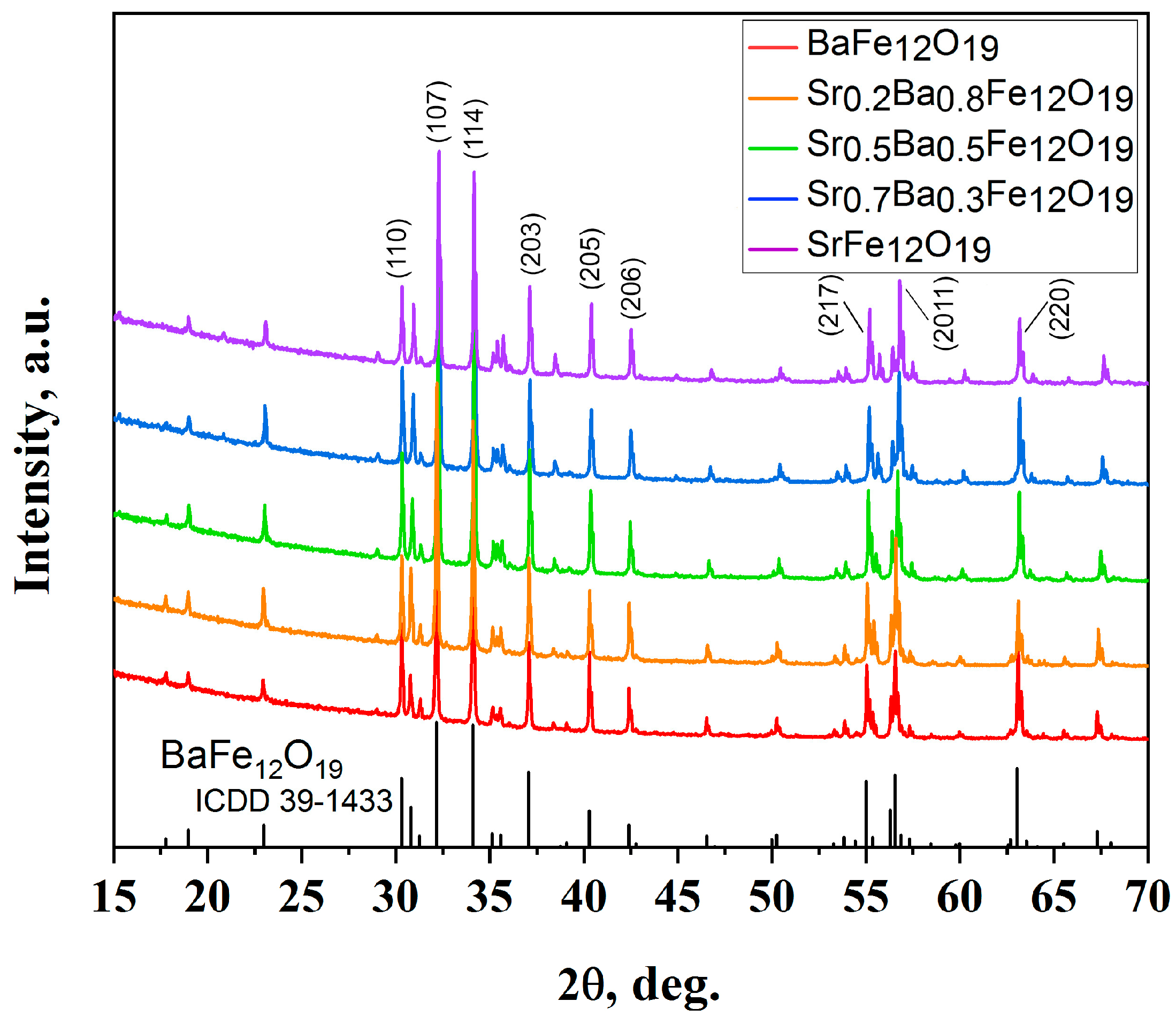
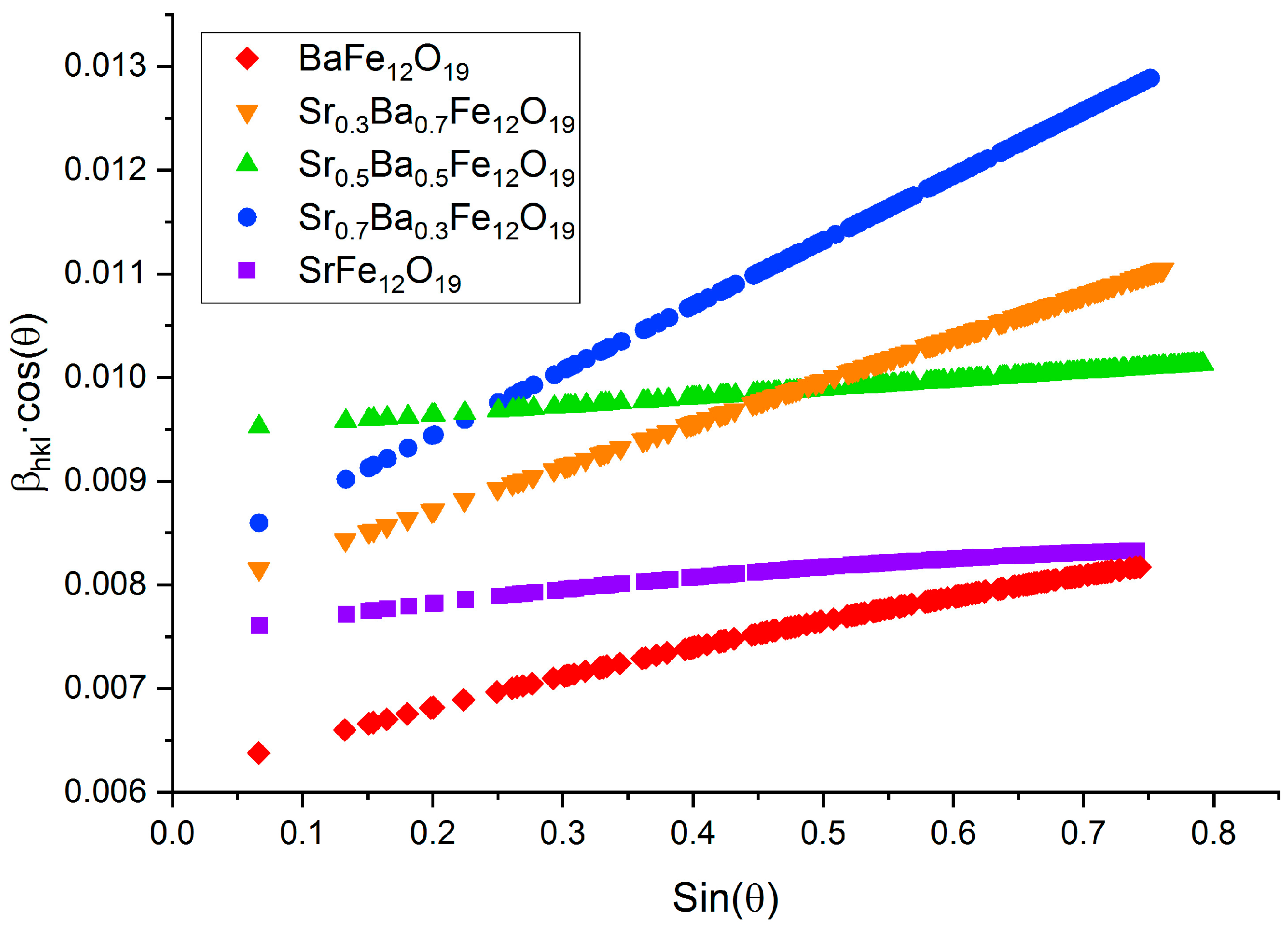



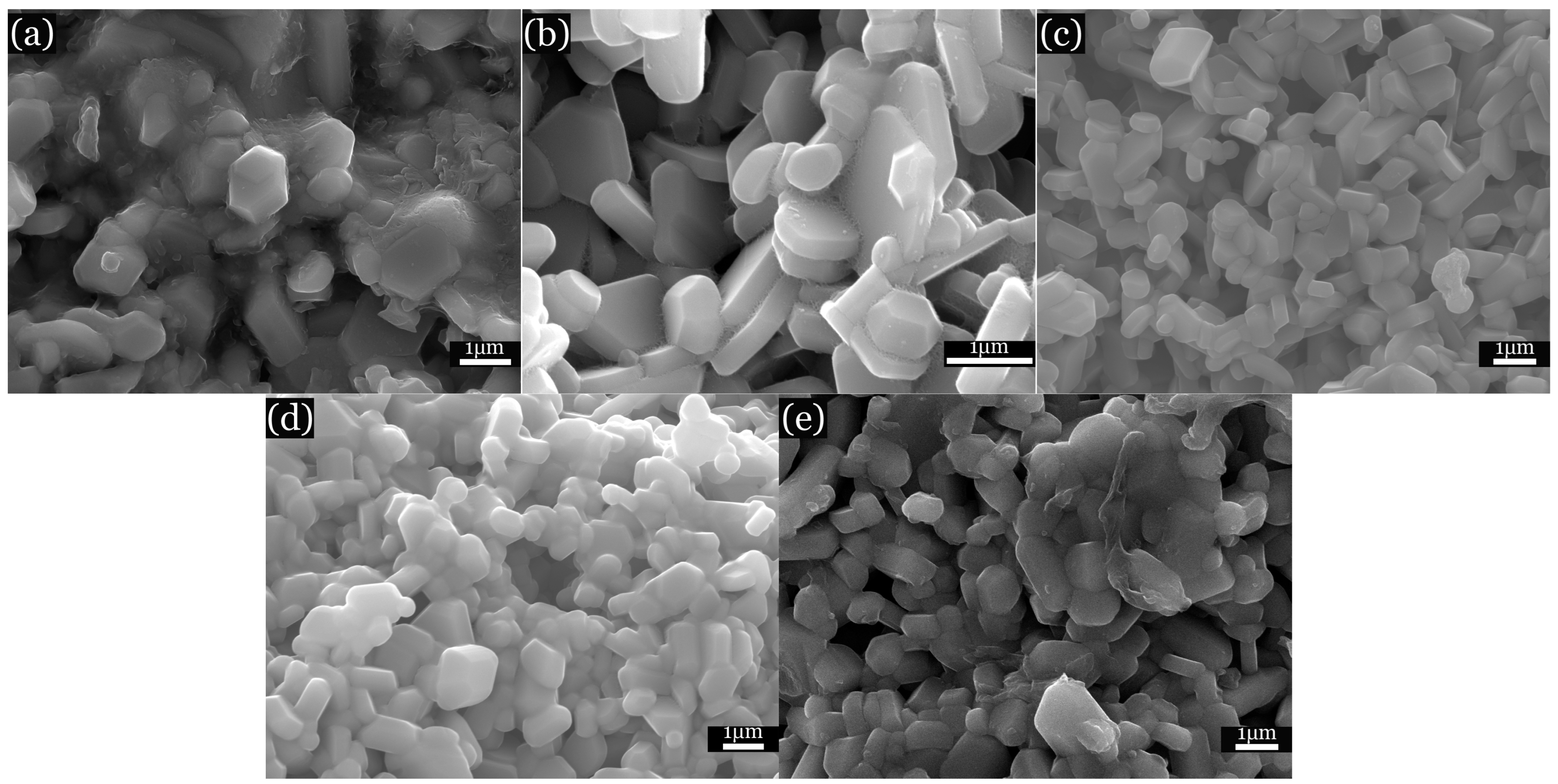
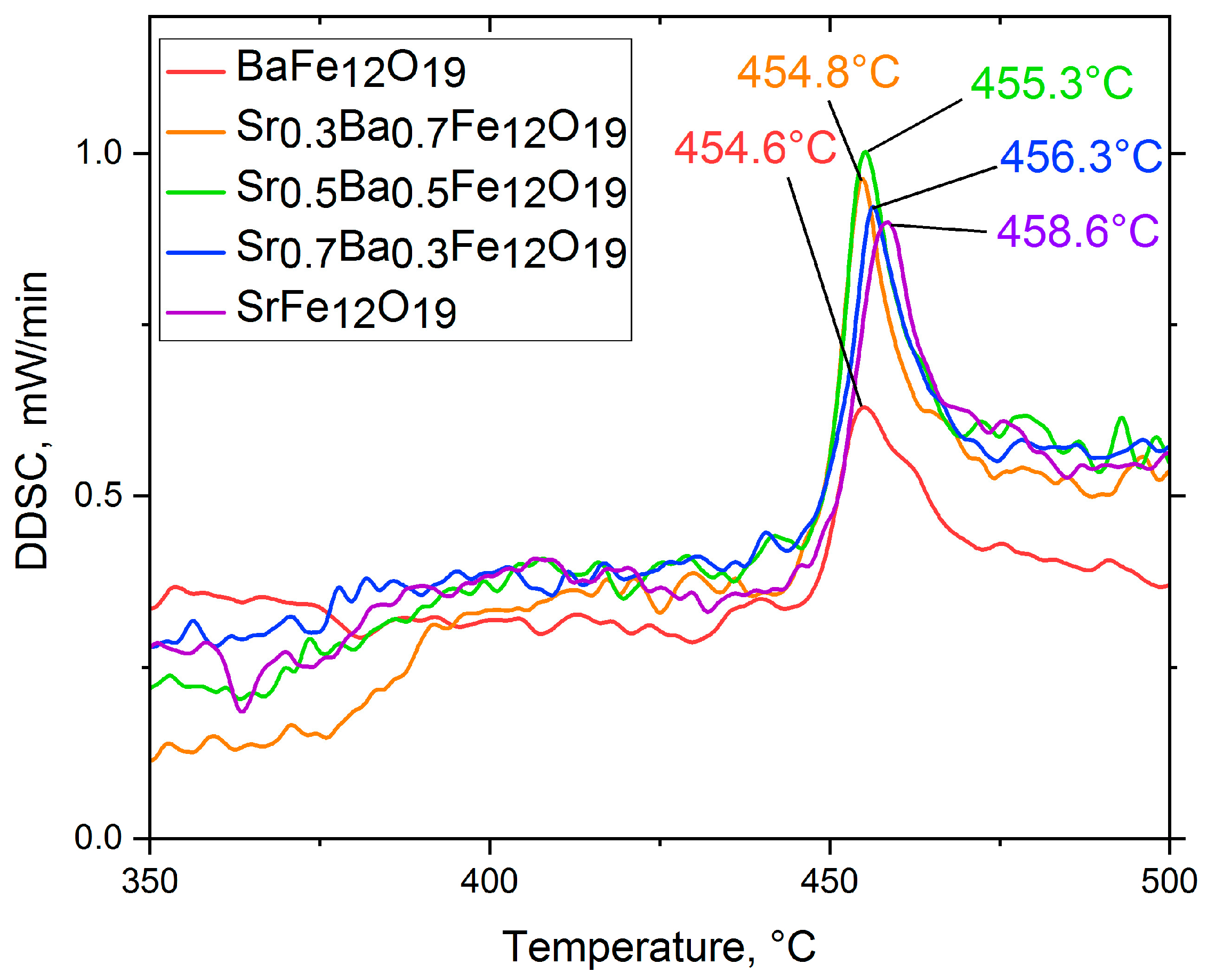
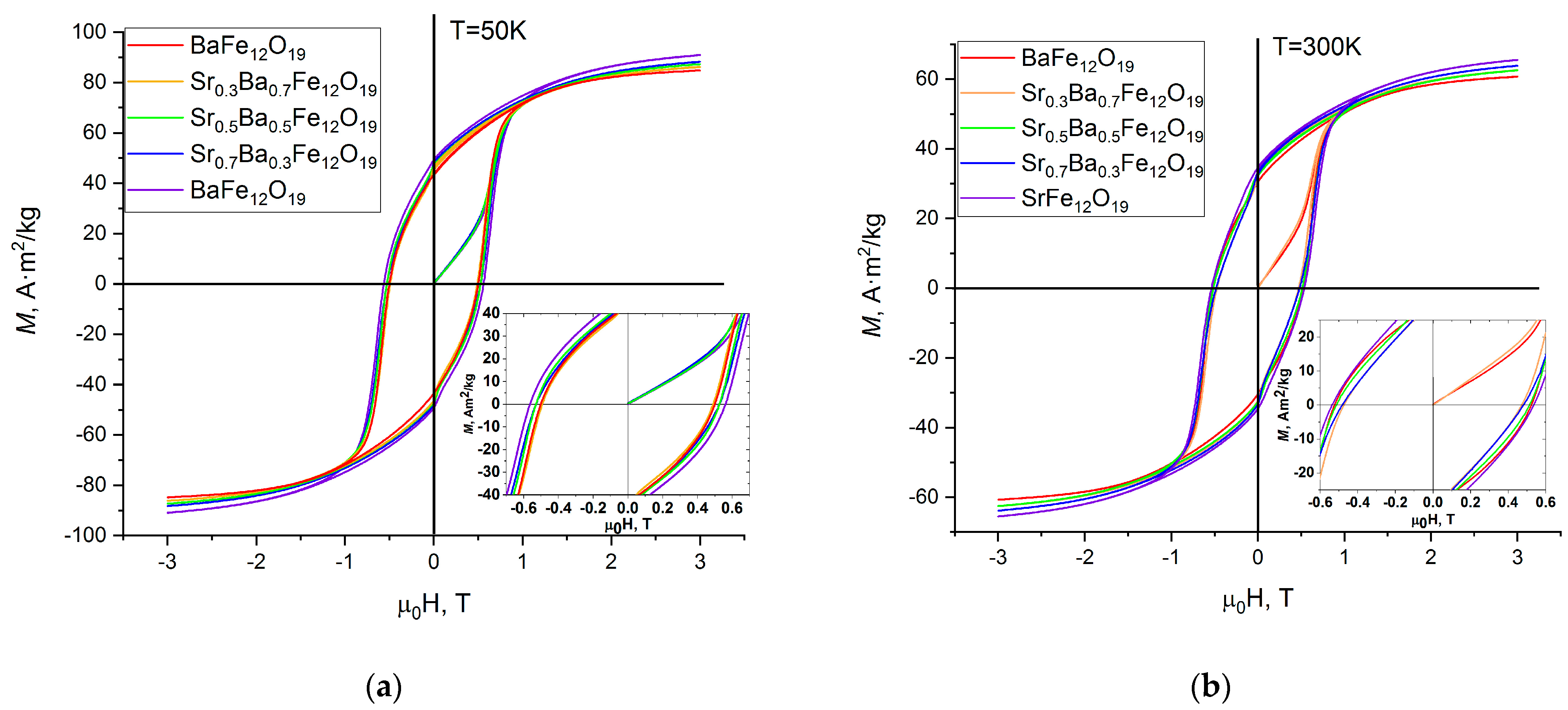
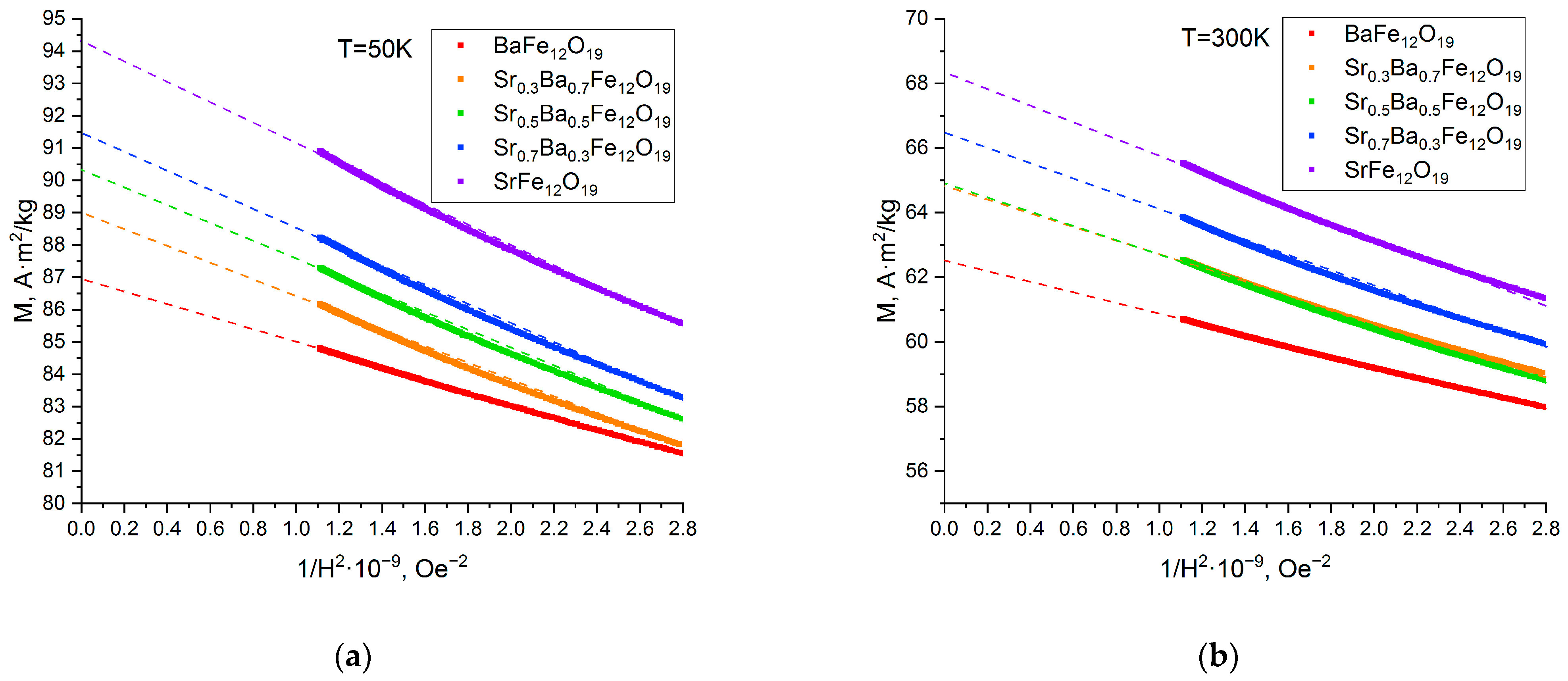
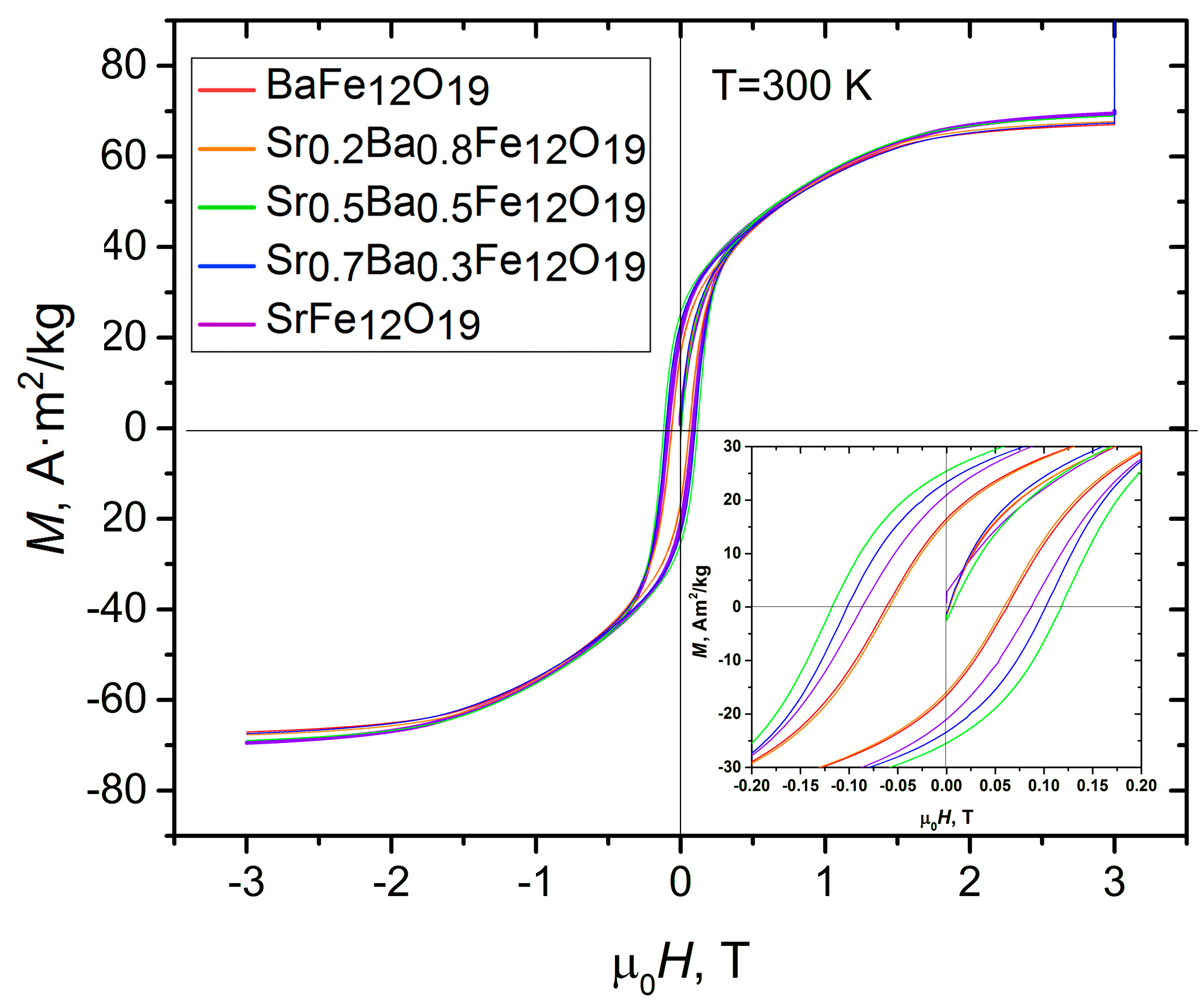



| Sample Composition | Tc, °C | a, Å | c, Å | Rp, % | Rwp, % | χ2 | D, nm | ε (10−3) | DR, nm |
|---|---|---|---|---|---|---|---|---|---|
| BaFe12O19 | 454.6 | 5.9040 | 23.2772 | 2.22 | 3.10 | 2.3 | 24.1 | 0.63 | 22.4 |
| Sr0.3Ba0.7Fe12O19 | 454.8 | 5.8996 | 23.2124 | 2.33 | 3.13 | 2.1 | 19.5 | 1.03 | 17.7 |
| Sr0.5Ba0.5Fe12O19 | 455.3 | 5.8918 | 23.1595 | 1.84 | 2.43 | 1.7 | 16.2 | 0.20 | 17.1 |
| Sr0.7Ba0.3Fe12O19 | 456.3 | 5.8910 | 23.1384 | 2.10 | 2.94 | 2.1 | 18.8 | 1.16 | 16.1 |
| SrFe12O19 | 458.6 | 5.8789 | 23.0498 | 1.92 | 2.56 | 1.9 | 20.0 | 0.23 | 18.0 |
| Sample Composition | 50 K | 300 K | ||||||
|---|---|---|---|---|---|---|---|---|
| Ms, A·m2/kg | Mr, A·m2/kg | Hc, T | Keff⋅105, J/m3 | Ms, A·m2/kg | Mr, A·m2/kg | Hc, T | Keff⋅105, J/m3 | |
| BaFe12O19 | 86.90 | 43.46 | 0.50 | 0.79 | 62.46 | 30.41 | 0.52 | 0.62 |
| Sr0.3Ba0.7Fe12O19 | 89.01 | 46.31 | 0.49 | 0.94 | 64.83 | 32.32 | 0.47 | 0.72 |
| Sr0.5Ba0.5Fe12O19 | 90.33 | 47.05 | 0.53 | 0.98 | 64.93 | 32.71 | 0.51 | 0.74 |
| Sr0.7Ba0.3Fe12O19 | 91.46 | 47.90 | 0.53 | 1.01 | 66.39 | 33.35 | 0.48 | 0.77 |
| SrFe12O19 | 94.34 | 49.22 | 0.56 | 1.06 | 68.24 | 34.61 | 0.54 | 0.81 |
| Sample Composition | Hc, T | Ms, A·m2/kg | a, Å | c, Å | D, μm |
|---|---|---|---|---|---|
| BaFe12O19 | 0.06 | 65.8 | 5.889 | 23.206 | 1.1 |
| Sr0.2Ba0.8Fe12O19 | 0.06 | 66.3 | 5.887 | 23.177 | 1.2 |
| Sr0.5Ba0.5Fe12O19 | 0.11 | 67.4 | 5.883 | 23.134 | 0.9 |
| Sr0.7Ba0.3Fe12O19 | 0.10 | 65.9 | 5.880 | 23.010 | 0.9 |
| SrFe12O19 | 0.09 | 67.9 | 5.879 | 23.049 | 0.9 |
| Sample Composition | β | B∙10−6, K−β |
|---|---|---|
| BaFe12O19 | 2.14 | 2.31 |
| Sr0.3Ba0.7Fe12O19 | 2.06 | 3.21 |
| Sr0.5Ba0.5Fe12O19 | 2.18 | 1.56 |
| Sr0.7Ba0.3Fe12O19 | 2.19 | 1.44 |
| SrFe12O19 | 2.16 | 1.79 |
Disclaimer/Publisher’s Note: The statements, opinions and data contained in all publications are solely those of the individual author(s) and contributor(s) and not of MDPI and/or the editor(s). MDPI and/or the editor(s) disclaim responsibility for any injury to people or property resulting from any ideas, methods, instructions or products referred to in the content. |
© 2023 by the authors. Licensee MDPI, Basel, Switzerland. This article is an open access article distributed under the terms and conditions of the Creative Commons Attribution (CC BY) license (https://creativecommons.org/licenses/by/4.0/).
Share and Cite
Kovalev, A.; Vinnik, D.; Gudkova, S.; Zherebtsov, D.; Zhivulin, V.; Taskaev, S.; Zhukova, E.; Ahmed, A.; Abramov, P.; Talanov, M. Magnetic and Terahertz–Infrared Properties of Nanodispersed Hexaferrite SrxBa(1−x)Fe12O19 Solid Solutions. Crystals 2023, 13, 1354. https://doi.org/10.3390/cryst13091354
Kovalev A, Vinnik D, Gudkova S, Zherebtsov D, Zhivulin V, Taskaev S, Zhukova E, Ahmed A, Abramov P, Talanov M. Magnetic and Terahertz–Infrared Properties of Nanodispersed Hexaferrite SrxBa(1−x)Fe12O19 Solid Solutions. Crystals. 2023; 13(9):1354. https://doi.org/10.3390/cryst13091354
Chicago/Turabian StyleKovalev, Andrey, Denis Vinnik, Svetlana Gudkova, Dmitry Zherebtsov, Vladimir Zhivulin, Sergey Taskaev, Elena Zhukova, Asmaa Ahmed, Pavel Abramov, and Mikhail Talanov. 2023. "Magnetic and Terahertz–Infrared Properties of Nanodispersed Hexaferrite SrxBa(1−x)Fe12O19 Solid Solutions" Crystals 13, no. 9: 1354. https://doi.org/10.3390/cryst13091354
APA StyleKovalev, A., Vinnik, D., Gudkova, S., Zherebtsov, D., Zhivulin, V., Taskaev, S., Zhukova, E., Ahmed, A., Abramov, P., & Talanov, M. (2023). Magnetic and Terahertz–Infrared Properties of Nanodispersed Hexaferrite SrxBa(1−x)Fe12O19 Solid Solutions. Crystals, 13(9), 1354. https://doi.org/10.3390/cryst13091354







